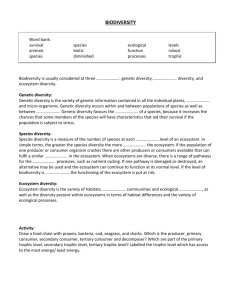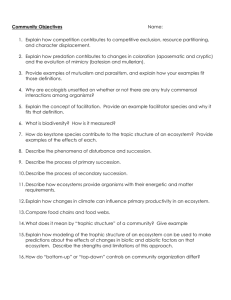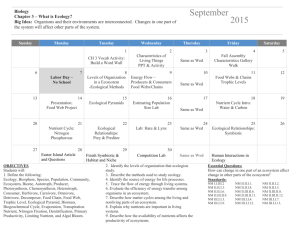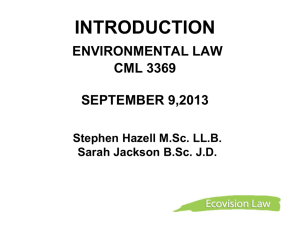Ecology Review
advertisement
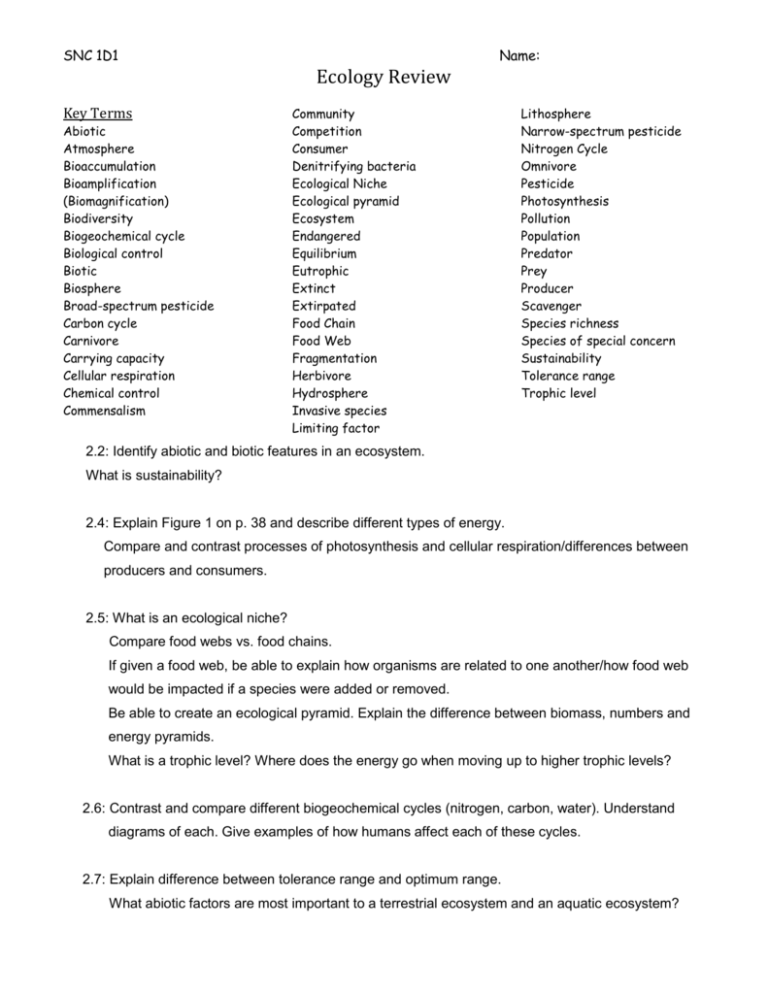
SNC 1D1 Name: Ecology Review Key Terms Abiotic Atmosphere Bioaccumulation Bioamplification (Biomagnification) Biodiversity Biogeochemical cycle Biological control Biotic Biosphere Broad-spectrum pesticide Carbon cycle Carnivore Carrying capacity Cellular respiration Chemical control Commensalism Community Competition Consumer Denitrifying bacteria Ecological Niche Ecological pyramid Ecosystem Endangered Equilibrium Eutrophic Extinct Extirpated Food Chain Food Web Fragmentation Herbivore Hydrosphere Invasive species Limiting factor Lithosphere Narrow-spectrum pesticide Nitrogen Cycle Omnivore Pesticide Photosynthesis Pollution Population Predator Prey Producer Scavenger Species richness Species of special concern Sustainability Tolerance range Trophic level 2.2: Identify abiotic and biotic features in an ecosystem. What is sustainability? 2.4: Explain Figure 1 on p. 38 and describe different types of energy. Compare and contrast processes of photosynthesis and cellular respiration/differences between producers and consumers. 2.5: What is an ecological niche? Compare food webs vs. food chains. If given a food web, be able to explain how organisms are related to one another/how food web would be impacted if a species were added or removed. Be able to create an ecological pyramid. Explain the difference between biomass, numbers and energy pyramids. What is a trophic level? Where does the energy go when moving up to higher trophic levels? 2.6: Contrast and compare different biogeochemical cycles (nitrogen, carbon, water). Understand diagrams of each. Give examples of how humans affect each of these cycles. 2.7: Explain difference between tolerance range and optimum range. What abiotic factors are most important to a terrestrial ecosystem and an aquatic ecosystem? SNC 1D1 Name: Know species interactions terms (See Table 2 on p. 54). Be able to identify which interaction it represents if given an example. What are limiting factors? What is carrying capacity? How do humans influence the carrying capacity of an ecosystem? 2.9: What is the difference between freshwater ecosystems and marine ecosystems? Which type of ecosystem makes up more than 70% of Earth? What is the difference between oligotrophic and eutrophic bodies of water? 3.3: How are humans affecting the rate of extinction? Distinguish between the different categories of species at risk (endangered, extirpated, threatened, special concern, extinct) 3.4: How does habitat fragmentation affect their sustainability? What factors improve sustainability of habitat fragments? (See Table 1 on p. 88) What human activities affect aquatic ecosystems? 3.5: What factors allow for an invasive species to be successful?/ What factors prevent an introduced species from being successful? What negative impacts can an invasive species have on an ecosystem? What is the difference between biological, mechanical and chemical control? 3.6: Explain environmental/ecological effects of acid precipitation, oil spills and plastics. Describe techniques used to deal with acid precipitation and oil spills. 4.4: What is the purpose of pesticides? What are some advantages and disadvantages of using pesticides? Distinguish between broad-spectrum and narrow-spectrum pesticides. 4.5: What are some issues with pesticide use? Explain the effects of bioaccumulation. How do the effects differ at different trophic levels?





